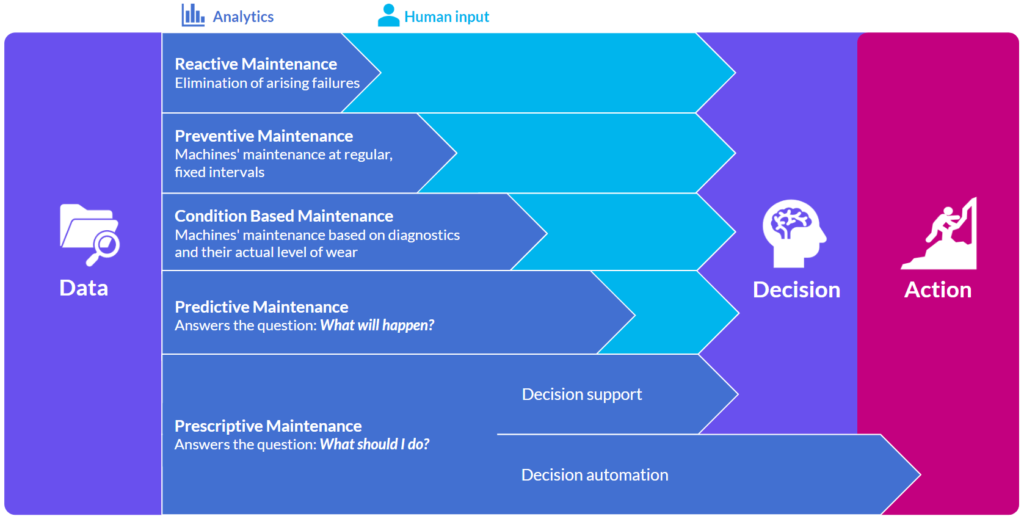

$ 18 billion – that’s how much in 2016, according to the National Institute of Standards and Technology of the United States, American entrepreneurs in the discrete manufacturing sector spent on production downtimes due to machine failures.
$ 100 billion – that’s the additional cost of their lost sales due to delays and defects as a consequence of these downtimes.
In this case, for every single dollar of direct costs of breakdowns and downtimes, there was more than five dollars lost further in sales. The mentioned data comes from the report: Economics of Manufacturing Machinery Maintenance. A Survey and Analysis of U.S. Costs and Benefits (NIST, 2020).
They can be significantly reduced by using modern technologies such as artificial intelligence and machine learning algorithms. The number of machine failures and production downtimes can be significantly reduced by monitoring the condition of devices in real time, detecting anomalies in their behaviour and predicting specific types of faults. This is the area of Predictive Maintenance (PdM), which I described in more detail in the article: The salesman’s perspective: Predictive Maintenance — what’s all the fuss about?
There are production failures and downtimes we cannot avoid even knowing about them in advance. In such a situation, you should focus on finding actions that will minimize production and business consequences of such events. And this is the domain of Prescriptive Maintenance (PRx).
It is another level of maintenance strategies, being an extension of predictive maintenance. Both fundamentally increase the efficiency of work aimed at maintaining production continuity. They both complement the traditional reactive-preventive approach with analytical knowledge that goes beyond human means in terms of the quantity and speed of industrial data processing.
Combining data from diagnostic sensors (i.e. vibrations, temperature, pressure, electrical measurements, environmental conditions, etc.) and IT systems supporting production processes (i.e. SCADA, DCS, MES, CMMS, ERP etc.) with machine learning algorithms, with the computing power of modern processors and expert knowledge, we can predict machine failures. By adding business data to this pool, we can create a system that generates recommendations (prescriptions) that facilitate making the best decisions in the event of various production events.
See the graph below for how maintenance strategies become more advanced.

Based on: Gartner Says Advanced Analytics Is a Top Business Priority (2014)
“Stop right now!” – PRx practically
Allow me to explain these approaches and technologies using a simple example from everyday life. We take care of our cars in various ways. Most often it is a mixture of reactive and preventive approaches. Their proportion depends on our whim, as well as the criticality and value of individual car components.
Reaction: We rather replace the car’s light bulbs when they burn out because such a repair is usually not complicated, expensive or immobilizing the vehicle.
Prevention: The timing belt, on the other hand, is replaced according to the manufacturer’s recommendations, at fixed intervals. Replacing the belt does not pose major problems, but its possible breaking is connected with immobilizing the vehicle and expensive repair of the engine.
Diagnostics and prediction: By equipping the car engine with appropriate diagnostic sensors, we could monitor its technical condition in real time. Properly analysed data from such a source would allow the assessment of real service life of individual components in specific operating conditions. This would make it possible to predict breakdowns and adjust service intervals, for example to the style of our driving. In case of a timing belt, prevention seems to be the right approach, but for components such as the crankshaft, I would like to know in advance about an impending fault. For example, before embarking on a dream off-road trip through the Kazakh steppes, where assistance might have some trouble to reach you.
Prescription: Staying in the world of motorization and long travels, I will add a prescription element to an already diagnosed and foreseen engine failure. What happens when a PdM system alerts about an impending failure? I could get a suggestion of recommended actions from the PRx system, for example:
These are abstract and very simplified examples that are clearly intended to reflect the idea of Prescriptive Maintenance. I hope I have achieved it. Let’s go back to the world of industrial machines. Here are some examples of prescriptions from the area that interests us most.
I learned first-hand the problems that PdM and PRx class systems solve.
Example no 1: If an upcoming failure of a compressor operating in a redundant system is detected, the PRx system will instruct the operator to switch the process to a backup compressor and the maintenance department to repair the main unit.
Example no 2: For a device with an overheating bearing, the PRx system will propose two scenarios. Maintenance staff can spend, for example, 20 minutes to lubricate the bearing, and the result of the repair will probably last two days until the planned service downtime. Optionally, they can replace the bearing immediately, which would take three hours, but keep the part running for another two years.
Example no 3: In the event of detecting an impending failure of an electric motor, the PRx system estimates the remaining time to failure and its criticality level, checks the maintenance staff base and their availability, as well as the availability of spare parts. As a consequence, the PRx system will inform all participants of the process in order to appropriately speed up service activities after analysing the available resources.
Example no 4: If an impending pump failure is detected, the PRx system will check the time to the next scheduled shutdown and recommend that the pump load / speed be reduced to level X, which allows it to run continuously until the scheduled maintenance shutdown. In addition, the system will calculate the production losses due to reduced pump capacity and compare them with the losses due to immediate downtime, if any.
In the past, I was involved in the sale of materials that are key semi-products in the manufacturing processes of my clients. I was facing a market situation where the demand for my goods significantly exceeded the production potential, and deliveries had to rely on current production. I learned first-hand the problems that PdM and PRx class systems solve. Furthermore, I understand the value of tools that predict machine failures and prevent downtime of technological lines, and in a situation where downtime cannot be avoided – they suggest, based on solid data, how to best behave in specific circumstances.
The PRx system made it possible to easily compare production-financial losses
In example no 4, the installation is operating at partial capacity due to the decision to keep it running despite the impending failure. The PRx system made it possible to easily compare production-financial losses on lower line efficiency with the cost of lost sales and contractual penalties for unrealized orders, if a decision was made to stop it immediately. What a breakthrough it would be in making good business decisions quickly!
Currently, most maintenance decisions are made either based on engineering or strictly financial knowledge, and Prescriptive Maintenance using simultaneous technical and business data analytics builds a bridge between them, allowing for real-time cost estimation for various technological scenarios.
The synergy of Predictive and Prescriptive Maintenance allows not only to minimize the direct costs of failures and production downtime, but also indirect – commercial costs, which can be much greater, while being difficult to estimate.

$ 18 billion – that’s how much in 2016, according to the National Institute of Standards and Technology of the United States, American entrepreneurs in the discrete manufacturing sector spent on production downtimes due to machine failures. $ 100 billion – that’s the additional cost of their lost sales due to delays and defects as […]

May the only unpredicted events be wrapped up in a gift paper, carefully hidden as the best surprises. We wish you a very happy holiday season spent in great spirits! How useful was this post? Click on a star to rate it! Submit Rating Average rating 0 / 5. Vote count: 0 No votes so […]
 Reliability Solutions B.V.
Reliability Solutions B.V.
